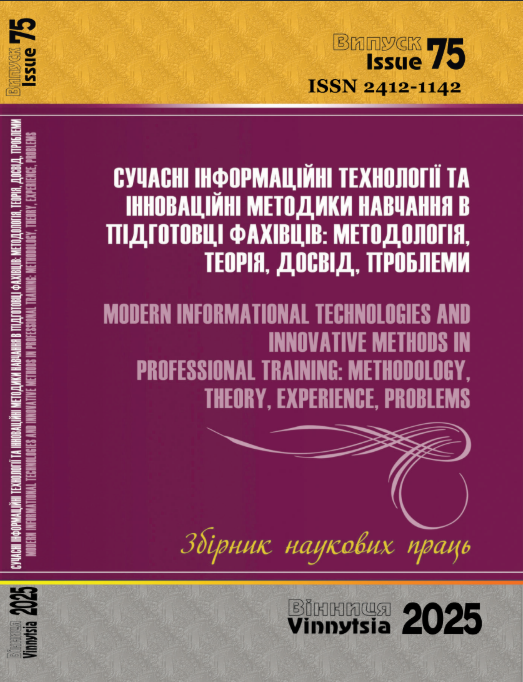POSSIBILITIES OF DIFFERENTIATING THE EDUCATIONAL PROCESS WHEN STUDYING A FOREIGN LANGUAGE IN HIGH EDUCATION INSTITUTIONS
DOI:
https://doi.org/10.31652/2412-1142-2025-75-98-105Słowa kluczowe:
differentiated approach; multi-level student group; foreign language learning; different styles of presenting information; performing tasks of various complexity; small student groups; differentiated assessment.Abstrakt
The article is devoted to the practical aspect of implementing a differentiated approach in the educational process when studying a foreign language (English). It is determined that student groups are multi-level in the English knowledge at the time of entering a higher educational institution. The last is meant to be the main reason for the need to implement differentiated learning. It is emphasized that it is the differentiated approach that contributes to the implementation of the pedagogical principle of the feasibility of learning and is a driving force in increasing student motivation. In the specified context, differentiated learning means modifying the educational space to the educational characteristics and needs of students, without changing the goals of learning. The study determined the role and place of individualization of learning, namely as one of the main characteristics of the differentiated learning within a student group. The study found that the features of human perception and processing of information can become the main methodological basis for the implementation of differentiated approach in a foreign language studying. According to the results of our study, it is advisable to present foreign language thematic material in different styles in student groups: firstly, in the form of reading the topical text, secondly, noting new lexical units, then listening to audio of a native speaker or watching the video material on the topic and finally schematic reproduction of the main information elements. Such differentiated presentation of the the thematic material becomes the theoretical part of a foreign language class, which is followed by the practical part. During the study, it was emphasized that the most optimal at the practical stage is work in small groups, where students are divided into 3-4 people according to the level of proficiency in the foreign language. Performing tasks of varying complexity in small groups corresponds to the principle of feasibility and allows students to work at their own pace, according to their capabilities. In the specified context, we consider differentiated assessment to be no less important. Differentiated assessment is defined as an integral part of differentiated learning, which allows assessing each student's own individual progress, as well as the amount of work done by him. It is noted that differentiated approach is important for students, but not easy to implement, as it requires more time for the preparation on the teacher’s side. The problem is deepened by the lack of an appropriate methodological base: ready-made textbooks with audio and video support, differentiated tasks of varying complexity for different-level student groups, which in turn determines a niche for further methodological developments, scientific explorations and conclusions.
Pobrania
Bibliografia
Bowler, B. & Parminter, S. (2022) Mixed-level teaching: Tiered tasks and bias tasks. Methodology in language teaching: An anthology of current practice. Cambridge, UK: Cambridge University Press, Chapter 6, 59-68. DOI: 10.1017/CBO9780511667190.010 (in English) DOI: https://doi.org/10.1017/CBO9780511667190.010
Scrivener, J. (2005) Learning teaching: A guidebook for English language teachers. Oxford: Macmillan Education. 434 p. [online]. URL: https://jonturnerhct.wordpress.com/wp-content/uploads/2015/08/learning-teaching-by-james-scrivener.pdf (in English)
Ketsyk-Zinchenko, U. & Pomirkovana, T. (2022) Differentiation of English teaching in different-level groups of non-language faculties of higher education institutions. Current issues of the humanities, 56(2), 135-141. [online]. URL: http://www.aphn-journal.in.ua/archive/56_2022/part_2/21.pdf (in English)
Dychkivska, I. (2004) Innovative pedagogical technologies: a textbook. Kyiv: Akademvydav, 2004. 218 p. [online]. URL: https://eltutor.at.ua/Podskazki/Dychkivska.pd (in Ukrainian)
Romanov I. Differentiated learning in foreign language classes: role, content and prospects. Molodyi vchenyi: pedahohichni nauky. Odesa, 2018. No. 1 (53), 378-381. (in Ukrainian)
Luchkevych, V. (2022) Implementing a differentiated approach to learning a foreign language: theoretical and methodological aspect Pedahohichni nauky: teoriia, istoriia, innovatsiini tekhnolohii. Odesa, № 1(115), 252-260. (in Ukrainian)
Gladka, O. (2023) Implementation of a differentiated approach to foreign language teaching for students of non-philological specialties. Actual issues of the humanities, 60(1), 247-251.[online]. URL: http://www.aphn-journal.in.ua/archive/60_2023/part_1/36.pdf (in English) DOI: https://doi.org/10.24919/2308-4863/60-1-36
Tomlinson, C. A. (2001) How to Differentiate Instruction in Mixed-Ability Differentiated Instructions. Classrooms (2nd ed.). Alexandria, VA: Association for Supervision and Curriculum Development, 124 p. (in English)
Osaulchyk, O. (2018) Using mind maps as a basis for presentation in the process of teaching foreign languages in higher education. Innovatsiina pedahohika, № 8, 96-100. (in Ukrainian)
Anderson, K. M. (2007) Differentiating Instruction to Include All Students. Preventing School Failure. Vol.51(3), 49-54. [online]. URL: https://cmapspublic3.ihmc.us/rid=1H1QYBMQZ-LVS4GQ-5CW/Anderson_DI.pdf (in English). DOI: https://doi.org/10.3200/PSFL.51.3.49-54






